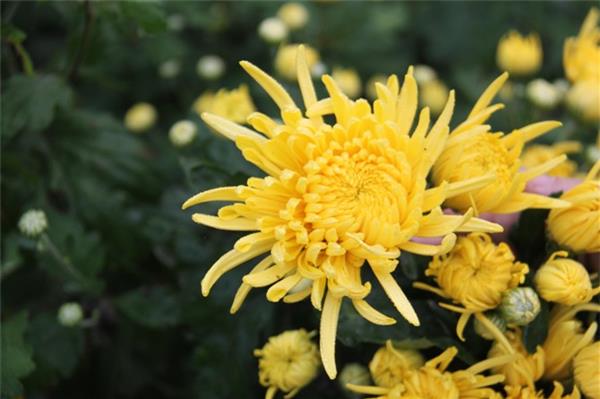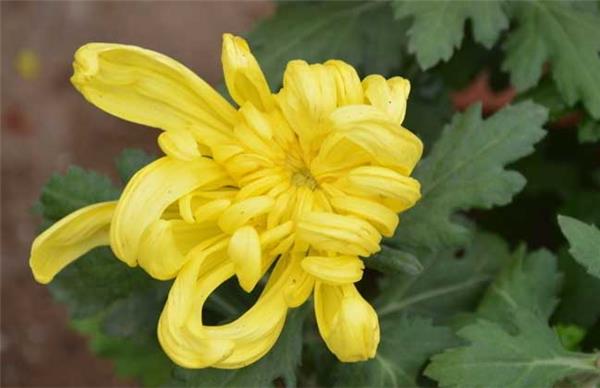[chrysanthemum seedlings] soil culture and soilless cultivation of chrysanthemum seedlings
The planting of chrysanthemum seedlings can be carried out either through soil culture or soilless cultivation, because the chrysanthemum itself has a strong adaptability, so let's introduce it in detail below.

Culture methods of soil-cultured Chrysanthemum
Potted soil: the potted soil should be loose and fertile with sandy soil. if the chrysanthemum is cut, choose cloudy or cloudy weather to pot in time after the chrysanthemum is planted. It can also be planted under the Arbor or under the sunshade net and placed under the sunshade net or Arbor for 3-5 days before normal management. In the process of continuous growth of the plant, the pot should be changed 2-3 times; if 60% rotten leaf soil, 10% cake residue and 30% sandy soil can be used, the plant can grow luxuriantly in summer and autumn and reduce the possibility of flower branches being attacked by diseases and insect pests.
Watering: whether watering is reasonable or not is important to the growth of chrysanthemum. Should achieve timely watering, hot summer season, water evaporation quickly, it is appropriate to water once in the morning, in the evening to make up "leaf water". When watering "leaf water", it is appropriate to spray the chrysanthemum plant with a fine-eye spray pot to increase the humidity in the environment and air around the chrysanthemum, but do not wet the pot soil so as not to overgrow the chrysanthemum. Watering in summer and autumn should also be determined according to different periods of chrysanthemum growth and different climatic conditions. If rainy days do not need watering, cloudy days less watering, sunny days should be more watering; autumn should be properly watered, hot summer should be watered more.

Fertilization: the amount of fertilizer needed at the seedling stage is not much, and nitrogen-based fertilizer is applied once a semimonthly to promote the growth of seedlings. Fertilizing in the high temperature period, the fertilizer liquid should not be too thick, so as not to damage the root system of the plant. After setting the head, the plant grows vigorously, and the amount of fertilizer required increases accordingly, and nitrogen-based fertilizer should be applied every 10 days. However, in order to control the growth, fertilization should be "thin fertilizer frequently". In late August, the application of nitrogen fertilizer should be stopped and the application of phosphorus and potassium fertilizer should be increased to facilitate the growth and growth of flower buds. Too much nitrogen fertilizer will lead to excessive vegetative growth of plants, which is not conducive to flower bud differentiation and budding. After the emergence of flower buds, more attention should be paid to topdressing phosphorus and potassium fertilizer to promote the growth of flower buds. After the flower buds are clear, fertilizer should be stopped.
Temperature: like cool climate, the suitable temperature for growth is 18: 221, which is 20: 22 ℃ in daytime and 16: 18 ℃ at night. It can tolerate the high temperature of more than 401, but the plant grows slowly at the high temperature of more than 30 ℃. After cool autumn, during the peak growth period, the optimum temperature for branch and leaf growth is 18: 221, about 20 ℃ during the day and 15 ℃ at night: the temperature is favorable for flower bud differentiation, and the optimum temperature during flowering is 13: 15 ℃. The developed buds can blossom normally under the temperature of 5 ℃, and the blooming flowers will not suffer from cold injury or frost injury under short-term frost and snow.

Culture methods of Chrysanthemum in soilless Culture
Upper basin: the surviving cuttlefish seedlings and plastic nutrition bags are placed in a 7-inch tile basin filled with 1 stroke and 3 cinders. Then slowly fill the clean mixed matrix (fly 2 + perlite 1 + peat 2) to the basin mouth 1 and 2, vibrate gently to fill, and pour water through the spray pot. Put it on a semi-shaded cultivation shelf. The mixed matrix can grow with the chrysanthemum plant and be added 2-3 times without turning the basin. Use broken tile pots to cover the substrate one after another to conserve soil moisture and fix plants.
Lighting: flowers like light, but avoid direct light. After the chrysanthemum seedlings are put on the pot, the chrysanthemum seedlings need to be planted on the shelf in the early stage, placed under 50% shading net and cultivated for 20-30 days. It only needs to be shaded at noon; in the high season from July to August, the strong light often burns the chrysanthemum leaves, the soilless matrix loses water quickly, evaporates the most, and affects the growth of chrysanthemum. 50% plastic shading net or Reed curtain is needed to cover the sprouting. At the same time of shading, spraying water several times in the shed before and after noon can reduce the temperature by 2 ℃-3 ℃, which is beneficial to the normal growth of chrysanthemum, and there is no shade all day from late September to October.
Nutrient solution: nutrient solution and water management: chrysanthemum nutrient solution is a full-element nutrient solution. Water it with a spray can. The concentration of the Beginning of Autumn before and after the Beginning of Autumn was 0.1%, 0.2% and 0.3%, once every seven days, and increased to 0.3% after mid-September.

Chrysanthemum is a kind of flower that can attract viewers at a glance, whether it is ground-planted chrysanthemum or potted chrysanthemum, can play a role in beautifying the surrounding environment, is a very popular flowering plant.
Related
- Wuhan Hospital Iron Tree Blooming Result Was Instantly Frightened by the Gardener Master
- Which variety of camellia is the most fragrant and best? Which one do you like best?
- What is the small blue coat, the breeding methods and matters needing attention of the succulent plant
- Dormancy time and maintenance management of succulent plants during dormancy
- Minas succulent how to raise, Minas succulent plant pictures
- What are the varieties of winter succulent plants
- How to raise succulent plants in twelve rolls? let's take a look at some experience of breeding twelve rolls.
- Attention should be paid to water control for succulent plants during dormant period (winter and summer)
- Watering experience of twelve rolls of succulent plants
- Techniques for fertilizing succulent plants. An article will let you know how to fertilize succulent plants.



